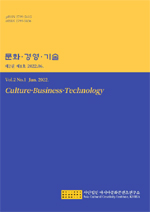학술논문
미야자와 겐지 동화에 나타난 아동관
이용수 45
- 영문명
- Perspective on Children in Miyazawa Genji’s Fairy tales: Focus on Suisen zukino yokka
- 발행기관
- 아시아문화콘텐츠연구소
- 저자명
- 간행물 정보
- 『문화·경영·기술』제2권 제1호, 37~52쪽, 전체 16쪽
- 주제분류
- 인문학 > 기타인문학
- 파일형태
- 발행일자
- 2022.06.30
4,720원
구매일시로부터 72시간 이내에 다운로드 가능합니다.
이 학술논문 정보는 (주)교보문고와 각 발행기관 사이에 저작물 이용 계약이 체결된 것으로, 교보문고를 통해 제공되고 있습니다.

국문 초록
본 연구에서는 미야자와 겐지의 동화「수선월 4일」을 중심으로 겐지의 아동관을 고찰했다. 겐지 동화에는 다양한 아동상이 등장하는데, 나이가 어린 아이일수록 자연에 가까운 존재이며 자연과 교감하고 감정을 나눌 수 있는 존재로 그려져 있다.
「수선월 4일」에서는 ‘하늘의 세계’・‘죽음의 세계’에 속하는 하늘의 아이 ‘설동자(雪童子)’와, ‘인간의 세계’에 속한 ‘아이(子供)’가 등장하는데, 두 ‘아이’는 각자 운명적으로 속해있는 세계의 질서에 따르지 않으면 안 되는 순수하면서도 무구한 존재로 그려져 있다. 서로 다른 세계에 속하며 질서에 순응해 살지만, 겨우살이 나뭇가지를 통해 ‘설동자’와 ‘아이’는 연결되고 삶과 죽음을 넘나드는 영역에서 교류하게 된다.
겐지 동화의 아동관에 대해 논한 쓰즈키하시 타쓰오는 “‘동심’을 이상화하고 절대화하는 일은 겐지에게 있어서 불필요했다. 왜냐하면 이상은 이미 법화경에 나타나 있어서 아동(인간)은 그것을 바라보며 나아가면 되기 때문에”1)라고 언급했는데, 오히려 절대적으로 ‘무구’ ‘무력’한 존재로서 그려져 있다는 점에서 겐지 동화에서 ‘아이’는 ‘이상화·절대화’되어 있다고 할 수 있다.
영문 초록
In this study, Perspective on Children in Miyazawa Kenji’s works was examined with a focus on the fairy tale Suisen zukino yokka.
In Miyazawa Kenji’s works, children appear in various shapes, and the younger they are, the closer they are to nature, and they are portrayed as beings who can communicate with nature and share emotions.
In Suisen zukino yokka, the ‘Snow Child’ belonging to the ‘world of heaven’ and the ‘world of death’ and the ‘Child’ belonging to the ‘human world’ must obey the world order to which they belong, respectively. It is portrayed as a pure and innocent being. They belong to different worlds and live in conformity with order, but through the mistletoe branches, ‘Snow Child’ and ‘Child’ are connected and interact in the realm of life and death.
Tatsuo Tsuzukihashi, who discussed the children’s view of Miyazawa Kenji’s fairy tale, said, “It was unnecessary for Genji to idealize and make ‘children’s hearts absolute. Because the ideal has already appeared in the Lotus Sutra, children (humans) can just look at it and move on.”
Rather, it can be said that the ‘child’ in the Miyazawa Kenji’s fairy tale is being ‘idealized and absolute’ in that it is portrayed as an absolutely ‘innocent’ and ‘powerless’ existence. The child is so helpless that he only wants to be saved. The clear and transparent cry of a child comes from Genji himself, and can it be said that the seeker Genji himself is.
목차
1. 들어가며
2. 이하토브 동화 「수선월 4일」
3. 설동자(雪童子)
4. 붉은 담요를 쓴 아이
5. 나가며
키워드
해당간행물 수록 논문
참고문헌
교보eBook 첫 방문을 환영 합니다!

신규가입 혜택 지급이 완료 되었습니다.
바로 사용 가능한 교보e캐시 1,000원 (유효기간 7일)
지금 바로 교보eBook의 다양한 콘텐츠를 이용해 보세요!






